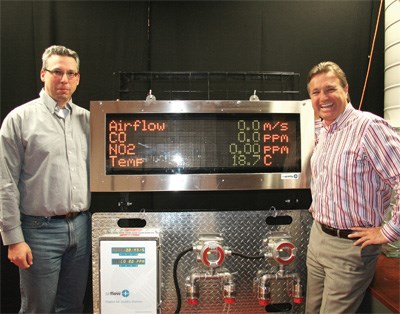A new and improved air quality monitoring system developed by startup Maestro Ventilation in Sudbury is already in 40 mines around the world after being on the market for just one year.
The product, Maestro Airflow, collects real-time air quality data and diagnostics from airflow and gas sensors throughout a mine at a fraction of the cost of conventional systems.
Partners Dave Ballantyne of Enfinitiy Inc. and Mike Gribbons ofSynergy Controls pooled their technology and marketing expertise to make it happen.
“We met at a restaurant over lunch to catch up with each other and Dave told me he came up with this really cool way of measuring airflow underground,” recalled Gribbons. “You plug it in directly to a network switch. I said ‘What about the PLCs and all of the other infrastructure.’ He said you don’t need any of it.
“We went to the clients and they said, ‘This is cool, but can we add gas analysis? Can we get the whole picture?’ This is how it morphed into an air quality system.”
According to Gribbons, a conventional air quality station costs approximately $60,000.
“Our equivalent is $15,000. Before, mines would have to build these big cabinets with engineer drawings. Now, we can offer them a fabricated device that’s all-inclusive. We can integrate in four hours, compared with weeks or months.”
In addition to capturing air quality data, the Maestro Airflow system alerts control room staff on surface if a sensor fails.
“We’ve developed a system that monitors right to the airflow or gas sensor level and it’s all digital, so it sends an alert back when there’s an issue,” said Gribbons. “This is radically different.”
Using conventional technology, gas sensors could fail and nobody would know.
In a ventilation-on-demand scenario, Maestro Airflow provides the reliable, real-time air quality data required to modulate fans.
“How do you do ventilation-on-demand if the data coming back is not correct?” asked Gribbons. “With our system, if there’s a problem, they’ll know about it on surface and someone can be mobilized to address it.”
Without diagnostics, a mine would have to delegate someone to go around and physically inspect all of the sensors.
“But mines don’t have enough labour,” said Gribbons. “More and more equipment is being added and they don’t have the people to maintain it, so this is our solution.”
The Maestro Airflow system can also control fans through a SCADA package on surface, remotely shutting them off prior to a blast, then turning them back on to clear the air. Having real-time information on gas levels, mine staff on surface can send crews back to the face as soon as the blast gases are dispersed.
“If they can get in there and start working a half hour earlier, that’s huge,” said Gribbons. The system is also able to open and close louvers.
Maestro software is web-based, which means there are no licenses or client-based upgrades. The application is accessible from any computer on the network through either Internet Explorer or Firefox browsers.
“Typically, with maintenance software, anytime you come up with an update, you have to revise the drivers,” said Gribbons. “In the instrumentation world, it’s not that easy. They have to send things out to get them updated. We’ve taken that complexity out of the picture.”
The Maestro offering expanded to include networked displays of air quality data at the request of Xstrata Nickel.
“They thought it would be really neat if they could get LED displays underground that communicate over the network switch,” said Gribbons. “It seemed like a fairly straight-forward task, so we said we’d give it a shot.”
Gribbons and Ballantyne looked for an off-the-shelf solution, but couldn’t find one, deciding in the end to develop something themselves.
“It seemed like a fairly straight-forward task, but it turned out to be a little more complex than we thought.”
The Maestro displays have been a big hit. Xstrata ordered 17 for its Nickel Rim South Mine in Sudbury, Vale has one at Coleman Mine with seven more on order and Barrick Gold has Maestro LED displays at its Goldstrike, Turquoise Ridge and Cortez Mines in Nevada.
The marquee displays convey real-time air quality measurements of airflow, carbon monoxide, nitrogen dioxide and temperature, as well as other information.
“They’re located at the entrance to a crosscut or a level, so the guys know what the condition of the air is,” said Ballantyne.
Typically, displays underground would be plugged into a computer. The Maestro display “runs completely off a network connection, so they can mount them away from a computer, which is the big difference.”
Maestro Ventilation is developing an international network of distributors to market its Airflow system. Gribbons’ company, Synergy Controls, which supplies automation and control solutions to a broad cross-section of industries, looks after customers in Ontario, Manitoba and Saskatchewan. Everest Automation handles sales in Quebec, and Minesite Technologies has been appointed as the company’s representative in Australia. Distributors for the United States and Mexico have yet to be appointed.



